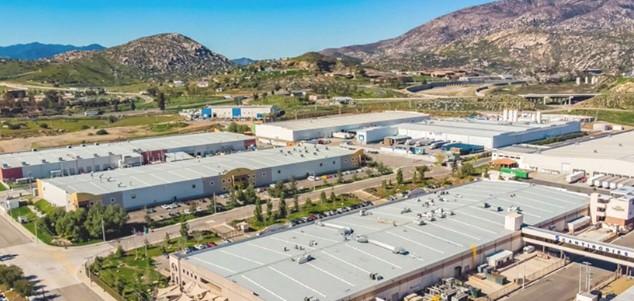
Will Trump’s Tariffs Slow Down Mexico’s Industrial Park Boom?

Despite uncertainty, Mexico’s industrial real estate remains one of the fastest-growing sectors in Latin America
Mexico’s Industrial Park Expansion: A Strategic Engine
Mexico’s industrial parks have become one of the cornerstones of the country’s economic transformation. As of Q2 2025, there are 477 active industrial parks nationwide, accommodating more than 4,000 tenant companies and generating over 3.7 million jobs, according to the Mexican Association of Private Industrial Parks (AMPIP).
Of these tenant firms, 44% are U.S.-based, 29% from other countries, and 27% Mexican-owned. Their activity is concentrated in key manufacturing and logistics sectors: automotive (32%), general manufacturing (36%), logistics (19%), e-commerce (8%), and beverages (2%).
Geographically, 54% of industrial parks are located in border states, 23.7% in the Bajío–West region, and 22.1% in Mexico City and its metropolitan area.
Together, these facilities form the backbone of Mexico’s export-oriented economy. The manufacturing sector alone contributes roughly 20% of national GDP, and foreign direct investment (FDI) continues to flow primarily into states with robust industrial park infrastructure.
From Pandemic Disruption to Nearshoring Boom
The industrial park boom began in the aftermath of the pandemic and accelerated as supply chain disruptions exposed global vulnerabilities. Rising tensions between the United States and China amplified Mexico’s strategic importance, as manufacturers sought to relocate operations closer to North American markets — a trend known as nearshoring.
By 2025, 103 new industrial parks are under construction, representing an investment of US$6.14 billion, up 12.1% from 2024. Of this amount, 63% is allocated to new park development, according to AMPIP data.
However, early signs of deceleration are emerging. In 2024, Mexico’s industrial parks absorbed 4.6 million square meters of new space, but the first half of 2025 recorded just 1.5 million square meters, while the vacancy rate rose from 3.7% to 4.9%. The absorption peak occurred in 2023, when a record 5 million square meters were leased.
Uncertainty from Washington
The question now looming over Mexico’s industrial property market is whether the return of Donald Trump to the White House — and his proposed new import tariffs — will dampen investor enthusiasm.
Industry experts remain cautiously optimistic. Claudia Esteves, Executive Director of AMPIP, acknowledged that “some projects are on hold, but not canceled.”
“The announcements from the U.S. government do create uncertainty, but within that uncertainty, Mexico always ends up better positioned,” she explained. “U.S. companies would be among the most affected by any new tariffs.”
Indeed, Trump and Mexico’s President Claudia Sheinbaum agreed in July 2025 to delay tariff enforcement for 90 days while negotiations continue, underscoring Mexico’s privileged trade position within North America.
AMPIP forecasts that once this temporary impasse passes, growth will resume. By 2030, Mexico is expected to host 583 industrial parks covering 104 million square meters, with 5,000 tenants and more than 4.5 million jobs.
Expert Outlook: The T-MEC Review and Investor Caution
According to Bertha Martínez, Coordinator of International Logistics at CETYS University in Baja California, continued expansion will depend heavily on the 2026 review of the USMCA (T-MEC).
“I believe the trade agreement will continue,” Martínez said. “What remains uncertain are the specific adjustments that could emerge from negotiations. The Trump administration seeks to balance trade by encouraging U.S. manufacturing — and that could directly affect Mexico’s automotive sector.”
Roughly one-third of industrial park tenants belong to the automotive industry. If stricter rules of origin are introduced or U.S. incentives pull auto production north, some facilities could be at risk. Yet Martínez emphasized that “the deep, integrated nature of the North American supply chain” makes large-scale relocations unlikely in the short term.
Francisco Muñoz, Executive Vice President for Industrial and Logistics at CBRE Mexico, agrees that uncertainty is creating a cautious environment:
“Companies are delaying expansion decisions until they see how the tariff discussions and USMCA review evolve. However, this stabilization has had a positive side effect — rental prices across Mexico have leveled off after a prolonged period of increases.”
The Bajío Region: A Growth Engine Beyond the Border
While northern border states have historically dominated industrial park activity, the Bajío region — encompassing Aguascalientes, Guanajuato, Querétaro, and San Luis Potosí — has emerged as a powerful second growth pole.
Fueled by automotive, aerospace, and data center investment, the Bajío offers competitive labor costs, strong logistics connectivity, and a skilled workforce.
According to CBRE data, the region recorded:
- 14.4 million m² of industrial inventory at the end of Q1 2025, up 4% year-on-year.
- Net absorption of 88,000 m².
- Gross demand (including land sales and expansions) of 175,000 m².
- 493,000 m² under construction, with 33% pre-leased.
In 2024, the Bajío states attracted US$4.33 billion in FDI, led by Guanajuato and Querétaro, which captured 47% of regional inflows — primarily from Japan, Germany, and Canada.
These figures confirm the region’s growing importance as a nearshoring hub, complementing the border states by offering lower congestion, lower wages, and increasingly advanced infrastructure.
Internal Challenges: Security, Energy, and Bureaucracy
Beyond external risks, Mexico’s industrial park developers face several domestic constraints:
1. Security
Cargo theft continues to pose challenges, particularly along major transport routes. The National Association of Private Transport (ANTP) reported 11,500 theft incidents in 2024, an 8% increase year-over-year. This raises logistics costs and deters some potential investors.
2. Energy Supply
Electricity demand is surging. AMPIP estimates that the 477 active parks require 13,200 megawatts (MW) of installed capacity, while the 103 new parks under construction will need an additional 2,434 MW. This underscores the need for targeted investment in energy infrastructure to sustain industrial growth.
3. Bureaucracy and Permitting
Developers face significant administrative hurdles. Building a new industrial park in Mexico requires navigating up to 34 permits at federal, state, and municipal levels. Although regulations specify time limits — for example, two months to obtain a water infrastructure permit — the process often takes up to 24 months in practice.
“What used to take six or seven months now takes a year or more,” explained Bertha Martínez. “Private industry moves fast because time is money, but regulatory compliance can slow everything down.”
A Temporary Pause, Not the End of the Boom
Despite the slowdown, Mexico’s industrial park sector remains fundamentally strong.
The pipeline of 103 new parks and 6 billion USD in investment signals sustained confidence.
Mexico retains geographical and trade advantages that no other Latin American country can match.
Over 60% of new foreign investment in manufacturing still targets Mexico’s industrial zones.
Even if U.S. trade policy introduces temporary turbulence, experts agree that structural factors — proximity, cost competitiveness, and skilled labor — will continue to drive industrial expansion.
As AMPIP’s Claudia Esteves summarizes:
“We are not facing a collapse, only a pause. The fundamentals remain solid, and once uncertainty clears, growth will resume.”
Conclusion: Resilience Beyond Tariffs
Mexico’s industrial parks represent more than just real estate — they are the physical backbone of North America’s new production map. With nearly 500 parks in operation, over 100 in development, and a growing share of global manufacturing, Mexico stands at the center of the nearshoring transformation.
The return of protectionist rhetoric in Washington has injected short-term caution into the market, but the long-term trend remains clear: Mexico continues to consolidate its position as the preferred manufacturing platform for the Americas.
As the 2026 USMCA review approaches, investors are likely to tread carefully. Yet the combination of geographic proximity, competitive labor, industrial infrastructure, and trade integration will ensure that Mexico’s industrial park boom does not end — it simply evolves.



